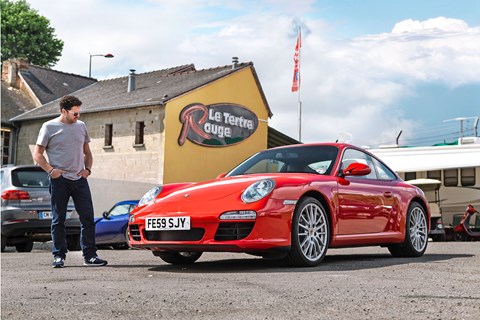► Diary notes on long-term 997
► Year-long test of six-year-old 911
► Living the dream? Or a nightmare?
Month 13 running a used Porsche 997: the conclusion to our long-term test
Is the engine in the wrong place? Would Porschefying our lives ruin our bank balances? Can you possibly justify spending forty large on a six-year-old, out-of-date car? Would decades of rave reviews end up unravelling under the cold scrutiny of day-to-day life with a truculent, impractical status symbol? All these questions – and more – have been bubbling away during our year-long tenure of a secondhand 997.
We’ve learned from research that nine-elevens most likely figure in your dream garage: they hail from that mystical sweet spot between the exotic and the attainable, and by picking an approved used one we hoped to discover whether we could hand-on-heart recommend you follow suit.
The Porsche arrived just in time for Le Mans 2014 and contributing editor Ben Oliver drove to La Sarthe as his first assignment in the Carrera 2. Our spec was tantalisingly close to perfection: it’s a second-generation 997 which ushered in the direct-injection flat-six and PDK twin-clutch auto, optioned with niceties such as zippily heated leather seats, extended nav package, Bluetooth phone connectivity and upgraded 19-inch alloys.
The car came from the Porsche Approved Pre-Owned scheme, arguably the safest way to source your organic used Pork. With it comes the security of a two-year warranty and breakdown cover in case things go wrong, and a 111-point bill of health and servicing top-up to make sure it doesn’t. Yes, you’ll find cheaper at supermarkets but we’d encourage you to check franchised dealers first; their prices are on occasion closer to reputable specialists than you may think.
We made one change to FE59 SJY before delivery, swapping the crap gearchange buttons on the steering wheel for a more intuitive paddleshift. What a difference! The plus/minus buttons on early Gen 2 cars are banished forever – they’re a rare Porsche faux pas – and the satisfying clunk of metal paddle (so much better than an F-type’s) has been a highlight of 911 ownership this year. It did cost us £865, mind.
I ended up quite liking the PDK transmission. Damned with faint praise? Early doors, I regretted our sports car not having the manual but, after a year of commuting and trudging to airports or around town, I’m almost convinced. You have to tap the Sport button first, to sharpen the shift speed, as it’s sluggish in auto mode. Truth is, the first-gen PDK isn’t as slick as later iterations, but the auto does add an extra degree of flexibility to the repertoire. Driven in manual mode, it’s nearly as satisfying as DIY.
With seven ratios, cruising is very relaxed indeed, the 3614cc flat-six burbling away at just 1900rpm in top. This helps fuel consumption and we were impressed by how close to the claimed average of 29.4mpg we came, routinely hitting 25mpg+. With a decent 64-litre fuel tank (three litres down on Carrera 4s, anoraks), we enjoyed a frisson of reassurance every time we filled up and saw 400 miles flash up on the predicted range.
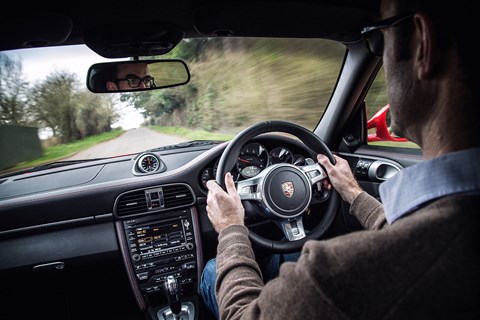
Nothing broke or failed in our year with the 911. Faults can be summarised on the fingers of one hand: the PDK threw a wobble twice and went into neutral at low, about-town speeds, but the problem disappeared; a rear exhaust finisher came loose and ended up at a wonky angle; and the front bumper had a small area of delamination, possibly after a power hose too many. But the 911 left us after nearly 13,000 hard miles of daily driving feeling as tight as the day it arrived.
Palpable engineering integrity is one of the crowning achievements of the 911. It feels so much better built than comparable exotica of this vintage – from the solidly assembled dashboard to the way it sits on the road, dives into corners and responds to every input into those precisely weighted, delicate pedals and (still hydraulically assisted) wheel. The leather hide felt like new, the air-con blew so cold we occasionally froze and the retro touches such as carpeted doors are beautifully finished.
Running costs were bearable, bar one pricey visit to Mid-Sussex Porsche at 32,820 miles. The scheduled service at £398 was very reasonable, but three tyres (£853), bi-annual brake fluid change (£114), six-yearly replacement filters, belts and fluids (£307), new catalytic converter heat shields (£241) and sundries sent the total spiralling to £2297. Be reassured that 911s only need maintenance every two years or 30,000 miles and those 19in N-rated Michelin Pilot Sports had 5mm at every corner when it left us.
Should you plunge your hard-earned into a similar 997-era 911? Our experience would resoundingly support you if you did. Its size remains a treat to use –narrow and wieldy enough to drive every day, the +2 seats great for kids – the drive never ceased to put a smile on our face and the best bit is solid residual values: it’s lost £9k in a year, less than our new Seat Leon Cupra 280 did. Keep it for longer – or life – and you won’t suffer that loss.
By Tim Pollard
Month 12 running a used Porsche 997: just how bulletproof is an old(er) 911?
Has anything gone wrong with our nearly-40,000-mile secondhand 911? Reliability has been robust for the past year, but we’ve had three blips in quick succession: two minor cosmetic flaws and a rather more ominous PDK fault experienced by two colleagues.
Those quad exhausts are in fact strapped-on finishers. Peer inside and you’ll see two smaller pipes within. Someone pointed out we were suffering from wonky pipes, as the right-hand pair had swivelled around. Easily solved by crawling underneath, adjusting the angle and tightening a bracket. Another fault belying this car’s six years is a small area of peeling lacquer on the front bumper; it’s not been hit, but I fear a power wash too many may have stressed the top coat.
Of more concern is the transmission warning light and lack of drive suffered by colleagues Ben Miller and Matt Tarrant, both at busy junctions. A simple switch-off-and-on routine fixed it both times and it’s not reappeared since. Otherwise, the 997 continues to shine and the flat-six feels bulletproof.
By Tim Pollard
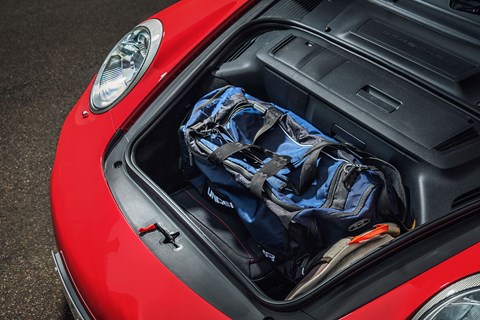
Month 11 running a secondhand 911: how practical is a Porsche?
Cards on the table: I’ve always preferred the mid-engined modern Porsches. My poison of choice? Cayman. So our year-long fling with a used 911 is a good test of my loyalty. And I’m fast learning the packaging genius of shunting the flat six engine backwards by a metre.
It’s the +2 bit of the equation that is really proving its worth. My kids are eight and six and those rear pews transform the car from serious sports coupe into genuine, surprisingly practical family transport for those with pre-teenage youngsters.
It’s a tight fit to scramble past the front seats into the second row but once installed the children never complain, calling the deep rear buckets their ‘thrones.’ That they don’t need boosters back there (unlike in mummy’s sensible crossover) is an added bonus. Rivals simply can’t match this 2+2 practicality, all thanks to that rear-engined layout.
I’ve yet to fold the rear seats down to chuck more bags back there, but it’s useful to know you can. The photo above isn’t staged: you really can pack a lot into the ‘frunk’ of the 997, especially if you stick with soft, squashable bags. Sharing much of their hardware, as they do, the Cayman/Boxster twins repeat the sizable boot trick even if they do miss out on the occasional rear seats.
It’s this versatility that worms its way into your affections as much as the Porsche’s punchy performance, its switchback poise, the trusty reliability. After all, if you can use a car more of the time, that surely broadens its appeal and makes it a properly rounded daily driver. And that’s exactly what the 997 has become: a brilliant, versatile sports car.
By Tim Pollard
Month 10 running a Porsche 997: the rear seats for kids
It might seem a strange question, but does a used Porsche 997 make a good family car? Depends on your kids. My two-year-old was happy – the rear seats don’t have Isofix, so your child seat needs to work with the diagonal seatbelt, but there’s plenty of room. (Isofix in the front is a retrofit option.) My 17-year-old was less happy: with his brother in the front, seat pulled forward, poor Seth was still jammed in, head cocked because of the sloping roof. Suddenly arriving at school in a Porsche didn’t seem quite so cool.
By Mark Walton
Porsche 911 diary dates: the colour game
Is a Guards Red nine-eleven a bit too clichéd? It's a colour many associate with the yuppyish excesses of the 1980s, for sure, but I've come to appreciate it. As Ben Oliver notes in his introduction (lower down this page), it is in fact the oldest colour in Porsche's colour chart, so comes with some heritage. And in an age dominated by endless palettes of silver and - nowadays - omnipresent whites, it's a refreshingly crisp, bright change. And if you can't have your sports car in bright red, then I can't think of a more acceptable recipient.
The paint is impressively crisp and even and unblemished, with only a handful of mild stone chips to ruin its six-year-old lustre. Seems to be hard-wearing then. The only bit of trim where we can see any sign of ageing is on the front bumper where a small area of lacquer appears to be peeling.
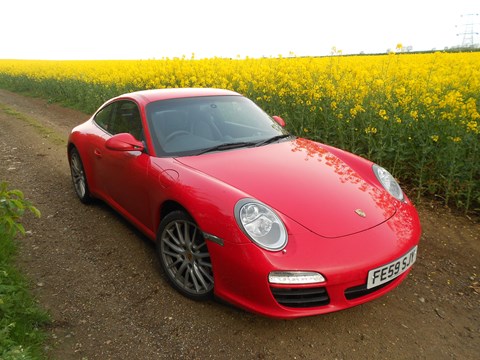
No complaints inside, where the 997 feels tight and wearing its age far better than some of the flimsier brand-new long-termers we see pass through our hands after one year. The leather is hard-wearing and durable, with just the right amount of patina and signs of comfortable bottom-cradling after 40k miles. The seat padding itself is as good as new. As you can tell, life with our secondhand 911 is going rather swimmingly. It's a bright point in my motoring career.
By Tim Pollard
Month 9 running a Porsche 997 Carrera: playing the generation game
Might you plough your carefully built-up SCARF (or Sports Car Acquisition Rainy-day Fund) into a used Porsche 911? Or will you be forever worried about having yesterday’s model? This strikes at the heart of our year-long test of this 997, acquired through Porsche’s own approved used scheme. So when a brand-new 991 Turbo S Convertible recently passed through CAR Towers, it seemed remiss not to compare new and old. They’re at opposite ends of the 911 periodic table, but this not a lab test, it’s an anecdotal glimpse at the car’s ageing process.
Our car is now entering its sixth year and is bearing up remarkably well. Sling a private plate on our Carrera 2 and nobody would guess we’re a generation behind. That Guards Red bodywork is in fine fettle and I’m relieved/delighted/agog to report that every 19in alloy is unblemished, even after 35k miles. Lined up beside the newer 991, the evolution is noticeable, especially since our Turbo wears the wide-hipped 4wd shell. New lamp graphics are another giveaway.
Inside is another story. Or so I thought… Mentally, I had pegged our 997’s cabin as feeling its age and I’ve not really clicked with the digital architecture of the centre console. It’s astonishing how quickly we now expect niceties such as DAB radio as standard (Fen FM is a bit rubbish) and the old-school sat-nav graphics move with an archaic judder.
So I jumped into the 991 expecting to fast-forward smugly into 2015 in a Matrix-like blur of binary clarity, but honestly things didn’t feel six years better. The digital heart is indisputably upgraded and the sharp resolution of the sat-nav and switchable instrument read-out is heaps better. But I was left nonplussed. The blunderbussing of switches across the centre console and transmission tunnel has always been messy, and I returned to the 997 actually preferring its simpler ambience and black leather.
Less surprising are the mechanical upgrades on the latest 2+2. Although my least favourite 911, the Turbo S cab is still a devastating machine: mind-warp rapid, neat steering, quiet and with a slickness of gearchange that highlights our PDK twin-clutch ’box’s v1.0 status.
Which car would I sink my SCARF into? Putting to one side the – gulp – £107k price gap, I’d take our Carrera 2.
By Tim Pollard
Click here to read CAR's Porsche 991 Turbo Cabriolet review
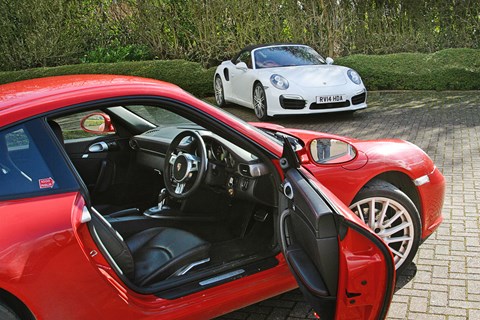
Porsche 911 diary notes: size, usability and sheer fun in spades
Unsurprisingly, our secondhand 997 is proving popular around these parts. Contributing editor Mark Walton snaffled the keys for a week as he headed north on holiday. Editor Phil McNamara borrowed it for a trip to the West Country at the weekend. Add in my own Easter holiday and a trip to the New York motor show plus a few diary clashes, and I've not driven the Guards Red Porsche for three weeks.
They say absence makes the heart grow fonder, and you can sure say that about the 911. I've driven it every night this week so far and reacquaintance has been a joy. The sun's shone, the last frosty clutches of winter are receding and the coupe's back in its element.
After driving an array of other cars, returning to the 911 reminds of its biggest asset: its size. It's so compact and usable in modern-day Britain, that upright screen affording great visibility where the Lexus RCF I drove at the weekend has A-pillars like a wrestlers' forearms. Threading it along country lanes/city streets/anywhere is reliably a cinch.
And, at the risk of sounding like a wimp, this car is cementing my belief that the best models often lie at the bottom of a range. It might be heretical to say this around here, but I actually prefer the Carrera 2 to the upper-echelon Turbos and GT3s. I mean, who wants something faster than this 997.2 C2 PDK with the Sport Chrono pack that can crack 4.5sec 0-62mph? That Lexus sounded better, though - a reminder that our 911 sadly doesn't have the Porsche Sports Exhaust. A shame.
By Tim Pollard
Month 8 running a Porsche 997 Carrera: the 911 returns to Peterborough
It was too good an opportunity to pass up on. We sometimes swap ownership of our long-term test cars to ensure multiple perspectives on the vehicles we live with and drive 24/7. And when the chance arose to snaffle the keys to Ben Oliver’s used 911 for the second half of our test, my hand shot up faster than a class swot’s.
It’s a great chance to plug a five-year-old 997 into my life and understand why this sports car is for many the definitive My First Supercar. No, it has no warbling V8 or V12, the engine’s not in the correct place and it’s clearly too common to be a real supercar, but isn’t the Porsche a good first step up the ladder?
Transfer from Chez Oliver on the south coast to CAR HQ in Peterborough coincided with the onset of winter, so the first months were spent pussyfooting around getting to know each other. Happily, handling has been remarkably surefooted even in light snow and ice, and I’ve been impressed by the 911’s pert dimensions, start-first-time reliability and toasty heated seats that take the chilly edge off the cabin at réveil.
A few colleagues report that demisting takes longer than it should, but I’ve yet to notice. I’m too busy enjoying the classic 911 motifs, evolved at a glacial pace but looking all the better for a light smear of wintry muck.
By Tim Pollard
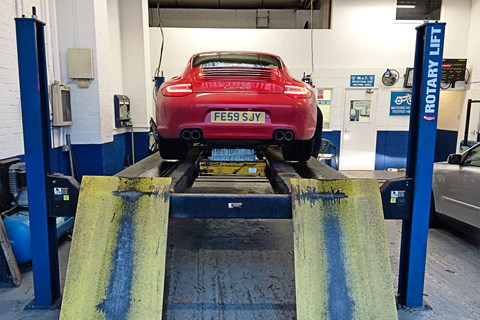
Month 7 running a Porsche 997 Carrera: service time
Better reliability and longer service intervals mean ‘our’ cars seldom see a four-post lift while in our care. Hence your interest in our used Porsche 911 Carrera. You do have to pay for servicing, and you probably wonder what sort of carnage a secondhand exotic would inflict on your finances were you brave enough to buy one instead of another new 3-series.
Well, here’s a partial answer. The last thing I did with our 911 before sending it up to CAR HQ for my colleagues to drive was to book it in for a minor service with my local dealer, Mid-Sussex Porsche. That ‘minor’ service on a car just over five years old and with 32,820 miles on the clock, was, including the VAT, £2297.08.
Call that minor?! Cue dozens of readers abandoning the idea of buying a used 911. But wait! That number includes three new tyres: the rears were shot, unsurprisingly, and there was a bulge in one of the fronts. The £710.91 ex VAT to replace them is about 20% more than the quotes I had from two major online discounters, so a few quid could have been shaved there, if I’d had the time. The service itself was £398.39, of which labour was £180. The car also needed its bi-annual brake fluid change (£113.96) and its six-yearly service items which seemed decent value at £307.46 all-in for air filters, PDK clutch fluid change and a new auxiliary drive belt.
A drone from the exhaust was traced to corroded catalytic convertor heat shields, both of which needed replacing at £241.15. An occasional creak from the front suspension was traced to a control arm which will be replaced later under the two-year Porsche approved warranty. New wipers, a new cover for the warning triangle which was eaten by mice (further damage was investigated but not found) and new coat hook for a Skoda-like £16.82 rounded out the bill.
It was big, but with the exception of the cat heat shields, none of it was either unexpected, nor particularly expensive. The dealership experience was slick, very time-efficient and felt suitably ‘premium’; thanks, Jackie. Reassuringly for next time, the front discs and pads were only showing 20% wear, and the rears 10%.
This car is proving our initial theory that with a decent warranty, you ought to be able to calculate your known service costs and likely depreciation, and figure out how much the thing is going to cost you. Running a 911 will never be cheap, but a car like this needn’t be ruinous either.
By Ben Oliver
Month 6 running a Porsche 997 Carrera: the big question - used Porsche or Maserati?
I feel terrible about writing this, but I’m going to anyway. I recently had lunch with a mate who knows a bit about fast cars: he works for the Bloodhound land-speed record project. He has just bought a 32,000-mile, 2006 Maserati GranSport: a tweaked version of the old Coupe with its Ferrari-sourced 4.2-litre V8. Like me, he has two kids, and he bought the Maserati because it’s an Italian sports car with a V8, but also because it has semi-usable rear seats. He didn’t try a 911 first. He wanted to meet up and drive mine to see if he’d made a terrible mistake. The look on his face told me that he knew he had, despite the Porsche’s smaller rear perches.
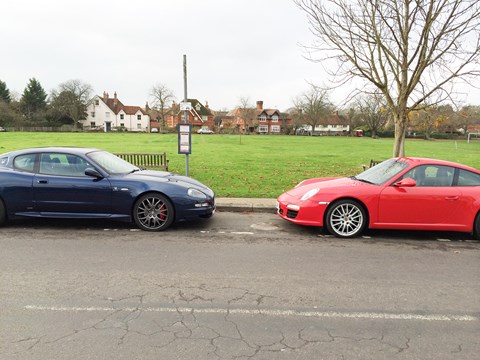
I drove his Maserati, and was frankly pretty shocked at how it has aged. The switchgear is flimsy, the suspension is hard and rattly, and the flyweight throttle and Cambiocorsa paddle-shift manual gearbox feel under-engineered. The engine is lovely, but after my rock-solid, basically as-new five year-old Porsche, the Maserati just feels like a big garage bill waiting to happen. It reminded me why 911s make such a smart secondhand buy. Oh, Richard, I’m so sorry. I know you love your car, but you should have tried a 911 first.
By Ben Oliver
Month 5 running a Porsche 997 Carrera: we catch a mouse in the frunk!
I worry about the great piles of useless car knowledge that lie like snow-drifts in my mind. When I opened the bonnet of the 911 to find rodent damage, from the dustiest corner of my brain came the fact that former tennis ace Sue Barker’s Ferrari 550 Maranello suffered thousands of pounds of damage when a mouse chewed through the wiring.
I had to Google this to be sure that I hadn’t just dreamt it. The Sun did report it, but that doesn’t make it true. Anyway, keen to avoid Sue’s misfortune (and bill) I decided to lay a mousetrap (first time I’ve done that in a car) and returned with one only to find the mouse looking up at me, before scurrying behind a plastic panel.
By next morning, it was an ex-mouse. See the value of these long-term tests In the 50 years CAR has been driving 911s, we never knew that the ‘frunk’ isn’t rodent-proof. I appreciate that this won’t be an issue for most 911 owners, whose cars live in garages like operating theatres.
Mine lives in a barn. Still, they read these reports in Stuttgart, so the next-gen 911’s boot will now be like Fort Knox to mice. And you will never forget that a mouse ate Sue Barker’s Ferrari.
By Ben Oliver
Month 4 running a Porsche 911 (997) Carrera: Ben Oliver gets tested/tortured at Porsche's Human Performance Centre
So after years of testing Porsches, it was finally Porsche’s turn to test me: its chance to exact revenge for the years of torture I have inflicted on its tyres, brakes and clutches. I expected it to be painful, and it was.
For most Porsche owners, a trip to the Porsche Experience Centre alongside Silverstone’s Hangar Straight is a pleasant day out. Access to the swanky clubhouse and the three miles of private test track (built on the old rally sprint circuit, used in Rally GB) are a considerable perk of Porsche ownership. Buy any new Porsche and you get a 90-minute session with one of the centre’s ‘driving consultants’ designed to get you comfortable with your new car’s power, and demonstrate how its safety systems might save your ass. As well as the handling circuit and a new set of straights for full-bore acceleration and braking, there’s a low-grip area, an ‘ice hill’, and a kick-plate which will snap your car’s rear end out in a random direction for you to save (or in my case, on several occasions, fail to).
If you’re a really serious customer, Porsche might also send you here to collect your 918 or your GT3, or even let you have a back-to-back test in cars with different specifications if you’re having difficulty deciding what options to tick. Given that ceramic brakes alone can cost as much as a decent family car, it seems only fair to offer you a test-drive.
You don’t automatically get a session at the centre if you buy an approved-used 911 like mine, but if you’re spending enough you can probably sweet-talk your dealer into sending you. And anyone can buy their way onto one of the ‘experience’ sessions in a specific Porsche model, or onto one of the longer courses designed to improve your driving skills.
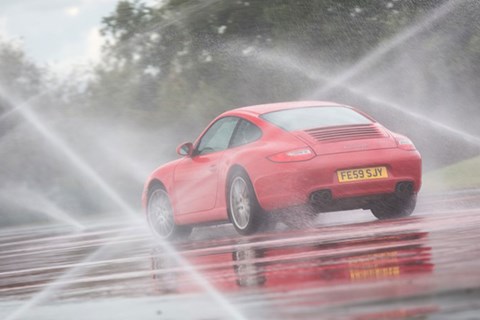
Given the towering ability of most modern sports cars, if you want to go faster the first thing you should improve is yourself. The Porsche Experience Centre doesn’t limit that to driving skills. It’s also home to the Human Performance Centre, run by a bunch of sadists with sports science degrees and past lives in the Spanish Inquisition. They have strong history of making fast blokes fitter. Mark Webber is a regular, and I nearly fainted at the sight of the 74 year-old Richard Attwood, one of my great heroes and Porsche’s first Le Mans winner in 1970, pictured in the brochure stripped to the waist on the treadmill having the special medical that ‘senior’ racing drivers require. The FIA should just give him a lifetime pass.
You don’t need to have a 911 to use the place, but it is a nice way to arrive. I booked in for a body composition analysis, in which a clever machine calculates what proportion of your body mass is water, skeleton, muscle and pie, and for a lactate-threshold test that helps you fine-tune your training. This one is properly cruel. You cycle for three minutes at a power output of 100 watts, after which someone sticks a needle in your finger to measure the lactic acid in your blood. Then they up the power by 25 watts for another three minutes, and jab you again. They keep doing this until you’re hitting your personal rev limiter and have the centre’s staff (and in my case, Le Mans winner and ex-F1 driver David Brabham, who just happened to be passing) standing around the bike, shouting at you and getting the next needle ready.
My own performance figures were rather less impressive than those I’ve extracted from Porsches over the years. But despite the dissolute lifestyle of the motoring journalist it seems I’m less close to death than I thought, and you might be reading my words for longer than you’d hoped. I left with the facts I needed to improve my own performance to match that of my glorious 911, and, after a quick spin around the centre’s newly expanded tracks, a clear plan to come back and explore my car’s limits, rather than my own.
By Ben Oliver
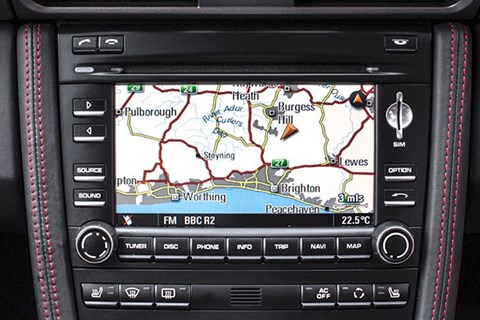
Month 3 running a Porsche 911 (997) Carrera: some of the tech is 10 years old
I am aware of how lucky I am to be driving a 911 every day. If any of the following observations seem churlish or spoiled, don’t hate me. The purpose of this test is to see what it’s like to live with a last-generation 911. That involves accepting that in return for a thumping saving on the price of a new car, your car won’t be the latest thing.
As previously reported, this matters less in a car as timeless as a 911 than it might in some others. You need a second look to tell my 997 from the newer 991, and Porsche cabins are so well-made that it feels as if these cars and the cockroaches would be the only things to survive nuclear holocaust. My car laughs in the face of the 26,000 miles it endured before coming to me.
But I’m also lucky enough to get to drive the very latest kit as part of my ‘job’. I’m aware of how quickly automotive tech is moving on; just how much new car my 911’s still-considerable £43,850 would also get you, and how much you’re foregoing by going used.
Mine is a second-generation and much updated 2009 997, but the car was originally launched in 2004, and much of it was unchanged in the update. And some of it does feel a decade old. It’s not important if you just want this car for the way it drives, but may be significant if you need to use it every day, as I do. You can spot the car’s age in the yellowy cabin lights (a £44k new car would have LEDs) and in the handbrake, which requires you to pull on an actual lever yourself.
These things are noticeable to someone used to the latest models, but not important. But the inaccurate sat-nav, clunky iPod and phone interfaces and the lack of some useful recent innovations like active cruise and digital radio remind you that five years – let alone ten – is a long time in technology.
By Ben Oliver
Month 2 running a Porsche 911 (997) Carrera: joining the village car show
Long, hot summer days and Guards Red Porsche 911 ownership are seriously detrimental to the productivity of the self-employed. Fortunately, I can’t actually see it from the window of my office at home, or I’d get no work done at all.
When you’re calculating the total cost of ownership of a used 911, you’re not being honest if you don’t include the value of the hours lost to 25-mile round trips to get a pint of milk. Or you can see it the other way, and justify the cost with the fact that you’re buying not only practical everyday transport – which this car is proving to be – but also a leisure activity: though there’s nothing particularly leisurely about the way it goes down the road.
Certainly, there’s little I could have bought new for the same money that would have won me invitations to exhibit at both our village ‘vintage’ car shows. Villa d’Este and Pebble Beach have nothing to fear from this corner of rural Sussex, yet.
But there was an impressive turn-out, including Edwardian Renaults and de Dions, a Model T, a pair of ’30s Rolls-Royces, various E-Types, and an ex-Duncan Hamilton Jaguar C-Type (the very first) towed by a MkVII saloon. Even against that lot, the 911 drew plenty of interested visitors. It might be a little more frequently seen, but it’s still one of the world’s great cars.
By Ben Oliver
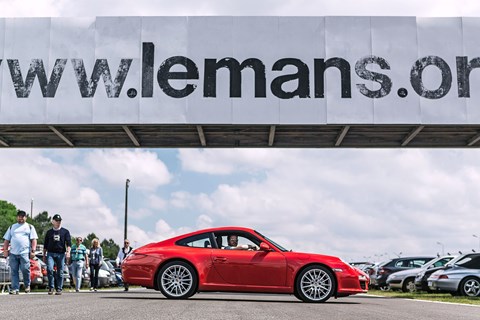
Month 1 running a Porsche 911 (997) Carrera: introducing our second-hand 911 test
As first drives in a new Porsche 911 go, this must rank pretty highly. Sun shining. Walk up to Guards Red 911, pop the front lid, throw in an overnight bag, then get behind the wheel and drive from Sussex to Le Mans to watch Porsche’s works return to the world’s greatest race after too long an absence.
And there was no pesky running-in period to spoil the fun. FE59 SJY is, you will have noticed, a three-and-a-half year old, second-generation 997, and arrived showing 26,601 miles. Almost all the long-term test cars we run are box-fresh, and might not even need a service in the course of a year’s use. A year in a new car is still revealing, and our experience useful to anyone considering buying one. But it doesn’t reflect how many of us buy cars. Some of us will buy only used, and most of us will consider swapping new-car smell for the pleasure (and associated risk) of buying something previously cherished, but two rungs up from what we could afford to buy new.
Click here for our original Porsche 997 review.
Research tells us that for many of you that wild-card used-car buy is a Porsche 911. Experience tells us that the 911 is so phenomenally well-made that nothing should go wrong in year one. Little is likely to go wrong in years four to five either, but this test should still make for a more interesting, relevant read.
And if there is a rainy day, we have the umbrella of the Porsche Approved Used scheme to protect us. It supplied our car, which has been through the scheme’s 111-point check and benefits from a comprehensive two-year warranty, which is effectively the same as that given to new cars. Once issued, mileage is not limited, which might be useful given the thousand miles I put on my car in its first weekend with me. And the two-year Porsche breakdown cover specifically includes recovery from a racetrack, which is generous and appropriate, but I hope unnecessary.
The theory is that with this kind of cover, you ought to be able to extrapolate your known costs (big services, etc) over the length of time you plan to keep the car, take a reasonable stab at likely resale value (not hard to work out, and the worst depreciation has passed) and calculate with some confidence what driving one of the world’s great sports cars will cost you. It will compare more favourably than you might think with buying something more mundane, but new.
(Please excuse the digression into service costs and depreciation4 and fuel economy here: I haven’t forgotten to be stupidly excited about driving a 911 for a year, but this stuff is important, right?).
To dial up the affordability angle to this story, and give me the man-maths ammunition to justify running a 911 rather than another sensible diesel, I was set on having a base Carrera. It’s easy to forget how gob-smacking this second-generation 997 was when it was launched in summer 2008. It got bigger brakes, a mild suspension rethink that finally tamed the 911’s nose-bob, and LED daytime running lights that are among the few ways to spot it from a first-gen car.
But more importantly, not only was it the first Porsche to get the firm’s PDK twin-clutch gearbox, but it also had an effectively all-new engine. Lighter, smaller, set lower in the chassis, with lower friction and a Bosch direct-injection system, it pulled off that rare trick of managing both a significant increase in power – up 20bhp over the old unit, to 341bhp – and an equally significant decrease in consumption and emissions: down 15% to just 225g/km. That still sneaks it inside band K for road tax, and will save you around £200 a year on anything vaguely comparable. And it will do 0-60mph in 4.7 seconds, or 4.5 if fitted with the optional Sport Chrono Plus pack, as mine is. 4.5 seconds! What am I doing at my desk writing this?
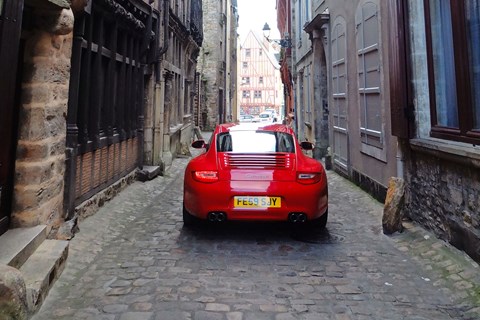
The 997 was launched in 2004, and this major revision wasn’t perfect. The exhaust note was muted and the wheel-mounted button-shifters were bafflingly crap, given that Porsche says it waited a quarter of a century between competing at Le Mans with a PDK ’box in a 956 in ’83 and putting it in a road car in ’08 to ensure it was ‘entirely perfect’. It wasn’t. Those buttons were Porsche’s biggest engineering mis-step in years. A paddle-shift option was soon offered, and the buttons subsequently forgotten.
One of the joys of an approved-used scheme is that it’s almost as good as speccing a car yourself, especially if you’re prepared to be patient. Buying a car at around three years old makes things even easier, as a lot come off lease and back into the dealer network at this age, so there’s more choice.
This car was chosen by Porsche to best represent their used offerings, and not by me. Had I been choosing for myself, I’d have picked a more subtle colour for daily use, and the sweet, simple five-spoke wheel. I’d have opted for the sports seats, as I find the squab in the standard seats too flat, and I’d have tried to find a car with the optional sports exhaust.
Most of all, I’d have picked a car without those bloody buttons, but the good news is that Porsche can replace them with a new wheel and paddles for a very reasonable £864.71, and you get to keep the old wheel to throw rotten vegetables at. So I had that done, and will also retro-fit ISOFIX mounts and airbag deactivation in the front, so I can carry our 16-month-old boy.
But the fact that this isn’t my personal choice of spec won’t colour the experience. You’ll be able to get pretty close to your ideal 911, and frankly, there’s no such thing as a bad one anymore. This car, before the mods, was offered at £43,850, against a list price of £62,899 new, and £69,538 with options at ’09 prices. Those include the PDK box (£2288 at the time), the 19-inch upgrade wheels (you won’t find many on the standard 18s) and inside, the extended nav package, heated seats, rear park assist, Bluetooth, an iPhone connection and contrast red stitching.
It looks sensational. The Guards Red – the oldest colour in Porsche’s paint pots – and the wheels are both growing on me, but that’s purely subjective. The standard, unadorned narrow-body 911 is a pretty thing, and although we criticised this second-gen 997 at launch for not signalling its engineering advances more clearly with a new look, you’ll be glad of Porsche’s glacial rate of design evolution when you buy used. This still doesn’t look like a superseded model, even when parked next to a 991, as it was often at Le Mans.
The wheels and bodywork show not a sign of the car’s (now) 28,000 miles. Same inside: other than some light scuffing to the kickplates, this looks and smells like the 997 press cars I was driving until recently. The front seats seem miraculously unworn, and those rears look like they’ve hardly been sat in (this is a joke). The controls feel as tight and consistently heavily weighted as ever, but that’s to be expected. 28,000 miles won’t trouble a 911 much.
And that first drive? As special as you might expect, and a foretaste of how good a year in a 997 might be. On the long drag down to Le Mans, its manners were perfect, the PDK’s super-overdriven seventh giving an easy, efficient cruise, with 28mpg and 300 miles between fills at a faster autoroute pace than we might choose in the UK. Around the tight corners and over the odd cobbled dips of the medieval centre of Le Mans it was wieldy and stress-free, unlike anything more exotic. But like those exotics, which abound at Le Mans, it still got the crowds excited enough to take its photo as it passed, and me excited enough to get drawn into a too-quick convoy on the way home which resulted in a brief, cordial and costly conversation avec les flics.
But most importantly, I swear I could feel the sway of that ancient circuit in the car that took me there: in its utter unburstability, in its meaty, deliberate controls, in the note of the flat-six engine design which has lapped Le Mans more often than any other. Other brands talk about the link between their road and race cars, but in a Porsche you just feel it. No disrespect to Audi, but even after all their wins at La Sarthe you’re not going to feel that in the mildly specced-up 2.0-litre TT you could buy new for the same money. I think it’s going to be a good year.
By Ben Oliver
